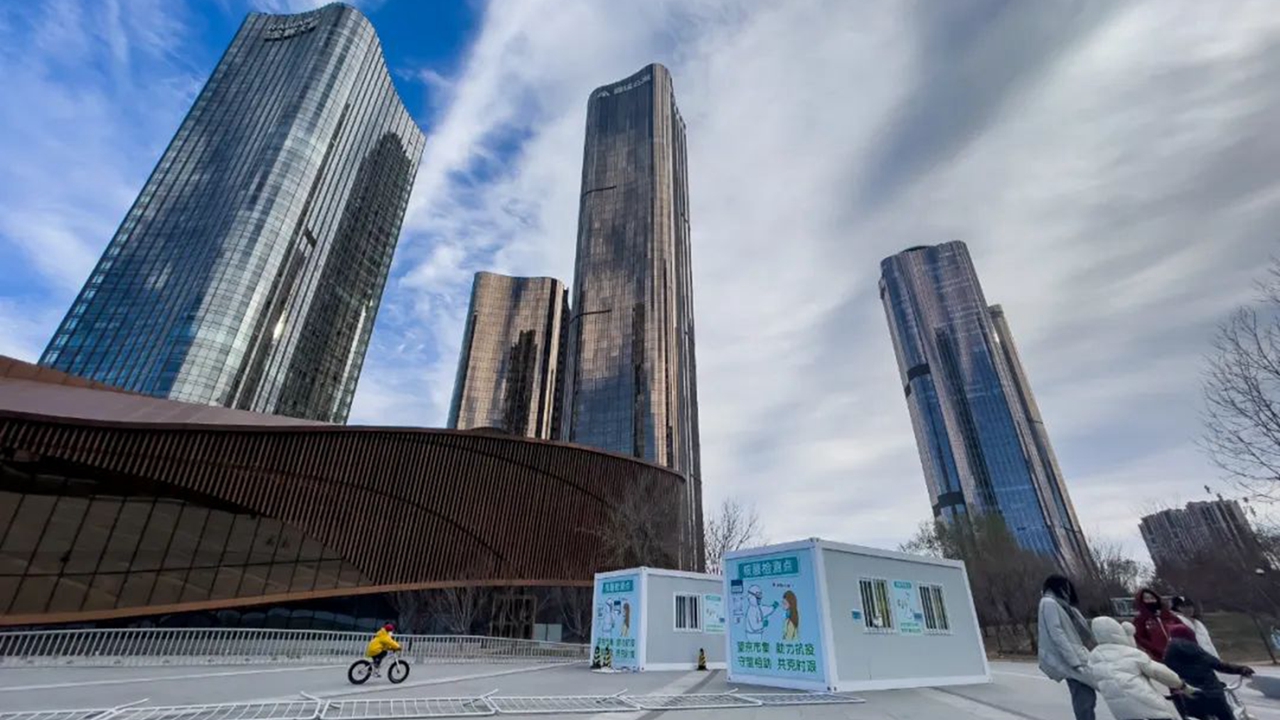Fight COVID misinformation
When some cities, Guangzhou in particular, started to ease COVID-19 restrictions last week, many people were relieved and excited over the prospect of returning to a normal life.
Still, some people grumbled that these cities were simply lying down. For them, anything less than frequent PCR tests and stringent lockdowns makes them worried, after almost three years living with restricted personal freedom.
Some of the reopening opponents might have developed a Stockholm Syndrome-like condition. But a lack of truthful information about the health consequences of contracting Omicron has been a key factor behind excessive fears over COVID-19 infection, and opposition to easing of restrictions.

Closed temporary nucleic acid sampling booths are seen in Chaoyang District, Beijing on Saturday. Beijing and some other Chinese cities have announced that COVID test results will not be required when using public transport. China News Service
On Friday, Guangzhou officials revealed that among all the 162,700 infection cases recorded in the city’s latest wave, 90% were asymptomatic, and only four were in severe and critical conditions. No deaths have been reported. Tang Xiaoping, one of eight medical experts who jointly issued their assessment of the Guangzhou wave, said symptoms of most confirmed cases in the latest resurgence in Guangzhou were very mild and similar to seasonal flu. Tang called for residents not to panic even though the daily infection numbers still hovered in thousands.
The release of such critical data is very important for local officials to draw up appropriate pandemic control and mitigation measures, and for the public to adopt a rational attitude towards Omicron, which Guangzhou health officials say has shown greatly reduced pathogenicity compared with earlier variants such as Delta and Alpha.
Over the past months, a lack of understanding of Omicron and its subvariants, coupled with other factors, has led localities to take excessive measures to contain outbreaks, leading to unnecessary lockdowns and excessive nucleic acid tests. Those who compared Omicron-induced symptoms to flu were attacked on social media as conspiring with the West in a plot to plunge China into a health crisis.
Some people also claimed that although Omicron is less deadly, it would still lead to millions of deaths in China in case of a full reopening, given the huge population and the shortage of medical facilities in rural areas. Such predictions were based on outdated overseas data, and failed to keep up to date with the traits of the prevailing variant.
Misinformation about sequela from COVID was also an important reason behind some people’s call for strict restrictions to stay. However, Guangzhou health experts pointed out last week that there was no evidence suggesting that COVID patients could suffer severe sequela.
COVID misinformation or misconception has also led to stigma against those infected. Discrimination against recovered COVID patients was reported from time to time. A 32-year-old woman took her own life in a makeshift hospital in Guangzhou last month partly because she was overwhelmed by the diagnosis and thought contracting the virus was a shame. She had told another patient in her ward that she and her husband, also infected, would not go back to her hometown for the next Spring Festival because they would be looked down upon for having contracted COVID.
In addition to dispelling misinformation and stigma, more effort should be made to quash rumors about the side effects of COVID vaccines.
Rumors that China’s COVID vaccines cause leukemia, lung nodules, infertility and other side effects have been circulating on social media in recent months, causing declining willingness to get vaccinated.
China is now aiming to boost mass immunization, especially among the elderly who are most vulnerable to developing severe and critical symptoms, as a gradual reopening has been set in motion.
Many people are elated by the removal of most COVID test requirements as restrictions are eased. However, this is also a time when we need to remain cool-headed.
We should bear in mind that the vaccination rate among the elderly people remains low and as a result they are under greater health threat. We should also keep in mind the fact that medical facilities in many parts of the country may not be able to handle a surge in hospitalization cases in the worst-case scenarios. Virulence data in other cities may not be as reassuring as in Guangzhou, and the risk that a winter COVID wave may coincide with seasonal flu should not be brushed aside.
While the government is making all-out efforts to roll out a new vaccination campaign and rushing to beef up medical infrastructure, individuals should shoulder their own share of responsibility and take necessary precautions, such as wearing a mask and keeping social distance in public areas, not only for their own health, but also for the safety of other people, especially the vulnerable groups.
Other cities should learn from Guangzhou’s move towards more transparency by asking medical experts to release more virulence data in a timely manner. Transparency will relieve citizens of unnecessary panic when severe cases and fatalities are low, and put them on alert when such numbers justify higher levels of concern.
(The author is a deputy editor-in-chief of Shenzhen Daily.)